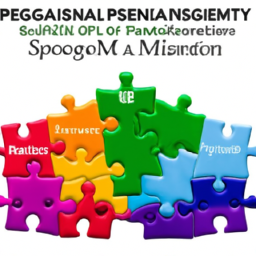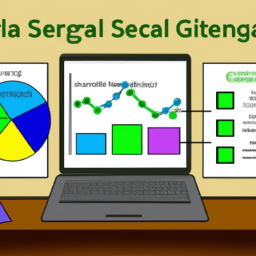So you want to become a Six Sigma Green Belt, huh? Well, buckle up because this certification is going to take you on a wild ride of skill mastery.
With a Six Sigma Green Belt, you’ll have the tools and knowledge to tackle everything from data analysis to process improvement. Get ready to dive deep into the world of statistical process control, problem-solving, and continuous improvement.
It’s time to level up your skills and become a lean, mean, process-improving machine. Let’s get started!
Key Takeaways
- Implementing the Six Sigma methodology within an organization
- Using statistical tools for analysis and problem-solving
- Utilizing data for data-driven decision making and continuous improvement
- Enhancing efficiency and productivity through Lean principles and project management
Understanding the Six Sigma Methodology
Understanding the Six Sigma methodology is essential for achieving success with a Green Belt certification. As a Green Belt, you will be responsible for implementing the Six Sigma methodology within your organization. This involves identifying and solving problems, reducing process variations, and improving overall efficiency.
However, implementing Six Sigma can come with its challenges. Some of these challenges include resistance to change, lack of employee buy-in, and difficulty in collecting and analyzing data.
Despite these challenges, the benefits of Six Sigma for organizations are significant. By implementing Six Sigma, organizations can achieve improved customer satisfaction, increased profitability, reduced waste, and enhanced process efficiency.
Understanding the Six Sigma methodology will equip you with the tools and knowledge needed to overcome implementation challenges and drive positive change within your organization.
Data Collection and Analysis Techniques
In this discussion, you will learn about the key points of Statistical Tools for Analysis, Effective Data Gathering, and Quality Improvement Through Data.
These topics will provide you with the necessary tools and techniques to analyze data effectively, gather data efficiently, and improve the quality of your work through data-driven decision making.
Statistical Tools for Analysis
You’ll quickly learn how to use statistical tools for analysis with a Six Sigma Green Belt certification. These tools are essential for interpreting and understanding data in order to make informed decisions.
Here are two key statistical tools you’ll master:
-
Statistical Modeling Techniques:
-
Regression Analysis: You’ll learn how to use regression analysis to identify the relationships between variables and make predictions based on the data.
-
Hypothesis Testing: This tool allows you to test the validity of a hypothesis by analyzing sample data and drawing conclusions about the population.
-
Data Visualization Techniques:
-
Control Charts: You’ll learn how to create control charts to visually monitor process performance and identify any variations or abnormalities.
-
Histograms: These graphical representations of data allow you to understand the distribution and identify patterns or outliers.
Mastering these statistical tools will enable you to analyze data effectively, identify areas for improvement, and make data-driven decisions to enhance organizational performance.
Effective Data Gathering
When gathering data effectively, make sure to use a variety of methods to ensure accurate and comprehensive information. Utilizing different data analysis techniques and process improvement techniques can help you uncover valuable insights and identify areas for improvement. Here is a table showcasing some commonly used data gathering methods:
| Data Gathering Methods | Advantages |
|---|---|
| Surveys | Gather opinions and feedback from a large number of people |
| Interviews | Obtain in-depth qualitative data and insights |
| Observations | Capture real-time behavior and interactions |
| Document analysis | Extract information from existing records and documents |
| Experiments | Test hypotheses and measure cause-and-effect relationships |
Quality Improvement Through Data
By analyzing data and implementing improvement strategies, organizations can enhance their overall quality and performance. Through data-driven decision making and process optimization, organizations can achieve significant improvements in their operations. Here’s how:
-
Data-driven decision making:
-
Utilizing data to identify areas for improvement
-
Analyzing data to uncover trends and patterns
-
Process optimization:
-
Streamlining processes to eliminate waste and inefficiencies
-
Implementing best practices to improve productivity and quality
By leveraging data and continuously improving processes, organizations can make informed decisions that lead to better outcomes. Data-driven decision making allows organizations to identify areas of improvement and make data-backed decisions. Process optimization ensures that operations are efficient and effective, leading to improved quality and performance.
With these strategies in place, organizations can drive continuous improvement and achieve higher levels of success.
Process Mapping and Value Stream Analysis
To effectively analyze processes and identify areas for improvement, it’s important to understand process mapping and value stream analysis. Process mapping involves creating visual representations of a process to identify and understand its steps, inputs, outputs, and interactions. Value stream analysis, on the other hand, focuses on identifying and eliminating non-value-added activities in a process to optimize its efficiency and effectiveness. To give you a better understanding of these concepts, here is a table summarizing the key differences between process mapping and value stream analysis:
| Process Mapping | Value Stream Analysis |
|---|---|
| Maps individual processes | Maps the entire value stream |
| Focuses on process steps and interactions | Focuses on value-added and non-value-added activities |
| Helps identify bottlenecks and inefficiencies | Helps optimize the entire process |
| Analyzes one process at a time | Analyzes the entire value stream |
| Provides a detailed understanding of a process | Provides a holistic view of the value stream |
Root Cause Analysis and Problem Solving
If you want to effectively identify the root cause of a problem and find a solution, it’s important to understand the process of root cause analysis and problem solving. Root cause analysis techniques and problem solving methodologies can help you systematically analyze the underlying causes of a problem and develop effective solutions.
Here is a breakdown of the process:
-
Root Cause Analysis Techniques:
-
Fishbone Diagram: This tool helps identify potential causes by categorizing them into different categories such as people, process, equipment, and materials.
-
5 Whys: This technique involves repeatedly asking ‘why’ to uncover the root cause of a problem by digging deeper into each answer.
-
Problem Solving Methodologies:
-
DMAIC (Define, Measure, Analyze, Improve, Control): This structured approach helps identify and solve problems by defining the problem, measuring the current state, analyzing the data, implementing improvements, and establishing control measures.
-
PDCA (Plan, Do, Check, Act): This method involves planning the solution, implementing it, checking the results, and making necessary adjustments to continuously improve.
Statistical Process Control (SPC
Now that you’ve learned about Root Cause Analysis and Problem Solving, let’s dive into the next topic: Statistical Process Control (SPC).
SPC is a set of techniques used to monitor and control processes to ensure they are operating within acceptable limits. By analyzing data and using control charts, you can identify any variations in the process and take corrective actions before they result in defects or failures.
The benefits of implementing SPC are numerous. It helps in reducing process variability, improving product quality, and increasing customer satisfaction. SPC also enables organizations to make data-driven decisions, leading to better process understanding and optimization. With SPC, you can proactively manage your processes and minimize waste and defects.
Now, let’s move on to the next topic: Design of Experiments (DOE).
Design of Experiments (DOE
Let’s explore the benefits of implementing Design of Experiments (DOE) and how it can help optimize processes and improve product quality.
-
DOE allows you to systematically test various factors and their interactions to identify the optimal settings for a process. By varying one factor at a time while keeping others constant, you can determine which factors have the most significant impact on the process output.
-
DOE helps you understand the relationship between process variables and their effects on quality characteristics. It provides a scientific approach to process optimization.
-
It reduces the number of experiments required to find the optimal settings, saving time and resources. It helps identify interactions between factors that may affect the process, leading to better understanding and control.
Implementing DOE in your organization can lead to improved process efficiency, reduced waste, and increased product quality. By using this powerful tool, you can make data-driven decisions to optimize your processes and achieve better overall results.
Lean Principles and Practices
In this discussion, you will explore the key points of Streamlining Processes With Lean, Eliminating Waste Using Lean, and Enhancing Efficiency Through Lean.
Lean principles and practices focus on optimizing processes, reducing waste, and improving overall efficiency. By implementing Lean methodologies, you can identify and eliminate non-value-added activities, streamline operations, and enhance productivity.
Streamlining Processes With Lean
You’ll be able to streamline processes with lean techniques to eliminate waste and improve efficiency. By implementing lean principles and practices, you can achieve a more efficient workflow and reduce unnecessary steps or actions. Here’s how you can make it happen:
-
Identify and eliminate non-value-added activities:
-
Analyze the entire process and identify any activities that don’t add value to the final product or service.
-
Eliminate or minimize these activities to streamline the process and reduce waste.
-
Optimize process flow:
-
Map out the current process flow and identify any bottlenecks or areas of inefficiency.
-
Implement changes to optimize the flow, ensuring a smooth and continuous process from start to finish.
Eliminating Waste Using Lean
Now that you understand how to streamline processes with lean techniques, it’s time to focus on eliminating waste using the same methodology. Lean techniques are all about identifying and reducing waste in order to improve efficiency and productivity. By eliminating waste, you can optimize resources and increase overall profitability.
Waste, in the context of lean, refers to any activity or process that does not add value to the customer. This includes defects, overproduction, waiting time, unnecessary transportation, excess inventory, unnecessary motion, and overprocessing. By implementing lean techniques, you can analyze your operations and identify areas where waste occurs. Once identified, you can then develop strategies to eliminate or reduce that waste, thus improving your processes and ultimately your bottom line.
With a six sigma green belt certification, you’ll gain the knowledge and skills necessary to identify and eliminate waste, making you a valuable asset to any organization seeking to improve efficiency and reduce costs.
Enhancing Efficiency Through Lean
To enhance efficiency through lean, focus on identifying and reducing waste in your processes. Implementing lean principles can help you streamline operations, increase productivity, and ultimately improve your bottom line.
Here are a few key steps to get you started:
-
Identify the eight wastes: Begin by understanding the different types of waste that can occur in your processes, such as overproduction, waiting time, unnecessary transportation, excess inventory, motion waste, defects, overprocessing, and underutilized talent.
-
Map your value stream: Create a visual representation of your processes from start to finish, including all the steps and activities involved. This will help you identify inefficiencies and areas where waste occurs.
-
Implement lean tools and techniques: Utilize tools like 5S, Kanban, Just-in-Time (JIT), and Total Productive Maintenance (TPM) to eliminate waste and optimize your processes.
Project Management and Leadership
Project management and leadership are essential skills that you can easily master by obtaining a six sigma green belt certification. This certification equips you with the necessary knowledge and tools to effectively manage projects and lead teams towards success.
With a strong focus on quality improvement and process optimization, a six sigma green belt certification provides you with a structured approach to project management, helping you plan, execute, and monitor projects efficiently.
Additionally, it enhances your leadership skills by teaching you how to motivate and guide your team members, effectively communicate with stakeholders, and make informed decisions based on data-driven insights.
Change Management and Stakeholder Engagement
When it comes to change management and stakeholder engagement, you need to focus on three key points: influencing stakeholder buy-in, managing resistance to change, and employing effective communication strategies.
Influencing stakeholder buy-in is crucial for ensuring the success of any change initiative, as it involves getting stakeholders on board and committed to the proposed changes.
Managing resistance to change is equally important, as it involves identifying and addressing any resistance that may arise during the implementation process.
Lastly, effective communication strategies are essential for keeping stakeholders informed and engaged throughout the change journey.
Influencing Stakeholder Buy-In
Influencing stakeholder buy-in is crucial for successfully implementing Six Sigma methodologies. To ensure that stakeholders are on board and supportive of the changes being made, you need to effectively influence their decision-making processes and engage them in the project. Here are some strategies to help you achieve stakeholder buy-in:
-
Clearly communicate the benefits: Clearly articulate the benefits that Six Sigma methodologies will bring to the organization, such as improved efficiency, reduced costs, and increased customer satisfaction.
-
Address concerns and objections: Take the time to listen to stakeholders’ concerns and objections and address them directly. Show them how Six Sigma can address their specific challenges and help them achieve their goals.
-
Provide evidence and data: Use data and evidence to support your arguments and demonstrate the potential impact of Six Sigma on the organization. This will help build credibility and convince stakeholders of its value.
-
Involve stakeholders in the process: Engage stakeholders throughout the entire implementation process, seeking their input and involvement. This will make them feel valued and increase their sense of ownership and commitment.
-
Build relationships and trust: Establish strong relationships with stakeholders based on trust and mutual respect. This will make it easier to influence their decision-making and gain their support.
Managing Resistance to Change
To effectively manage resistance to change, it’s important to address stakeholders’ concerns and objections and provide them with evidence and data to alleviate their doubts. By engaging with stakeholders throughout the change process, you can ensure their needs and perspectives are taken into account. This helps to build trust and collaboration, reducing resistance and increasing buy-in. To further illustrate the importance of managing resistance, consider the following table:
| Stakeholder Concerns | Evidence and Data |
|---|---|
| Fear of job loss | Provide data showing how the change will create new opportunities and enhance job security. |
| Lack of understanding | Share information and provide training to ensure stakeholders have a clear understanding of the change and its benefits. |
| Loss of control | Involve stakeholders in the decision-making process and provide opportunities for input and feedback. |
| Uncertainty about the future | Communicate a clear vision and roadmap for the change, outlining the expected outcomes and benefits. |
Communication Strategies for Change
When managing resistance to change, effective communication strategies are crucial. By utilizing these strategies, you can navigate the challenges that arise during change management and ensure a smooth transition for your team.
Some key communication strategies to consider include:
-
Transparent and frequent communication: Keep your team informed about the changes happening and the reasons behind them. This helps build trust and reduces uncertainty.
-
Active listening: Encourage your team members to express their concerns or questions and actively listen to their feedback. This shows that you value their input and can address any issues or misconceptions.
-
Provide clarity and context: Clearly articulate the goals and benefits of the change, as well as how it aligns with the overall organizational strategy.
-
Tailor your communication: Different individuals may have different communication preferences. Adapt your communication style to meet their needs, whether it’s through emails, meetings, or one-on-one conversations.
By implementing these communication strategies, you can effectively manage change and minimize resistance within your team.
In the next section, we will explore the importance of quality management systems (QMS) in the context of a Six Sigma Green Belt certification.
Quality Management Systems (QMS
Implementing a QMS is essential for organizations looking to enhance quality and ensure customer satisfaction. A QMS provides a systematic approach to quality control, allowing organizations to identify and address any issues that may arise during the production process.
By implementing a QMS, organizations can streamline their operations and optimize their processes, leading to increased efficiency and productivity. This systematic approach to quality management ensures that products and services meet or exceed customer expectations, leading to improved customer satisfaction and loyalty.
In addition to quality control, a QMS also focuses on process optimization, identifying areas for improvement and implementing strategies to enhance productivity and reduce waste. By implementing a QMS, organizations can achieve higher levels of quality and efficiency, ultimately leading to increased profitability and success.
Transitioning into the next section, team facilitation and collaboration are vital components of implementing a successful QMS.
Team Facilitation and Collaboration
When it comes to effective team communication, you need to focus on clear and concise messaging. It’s important to actively listen to your team members and ask clarifying questions to ensure everyone is on the same page.
Building strong collaborations involves fostering an environment of trust and mutual respect, where team members feel comfortable sharing their ideas and concerns.
Effective Team Communication
To effectively communicate with your team, you’ll need to actively listen and provide timely feedback. This is crucial for maintaining effective team dynamics and resolving conflicts efficiently. Here are some strategies to help you navigate team communication successfully:
-
Active Listening:
-
Pay attention to verbal and non-verbal cues, such as body language and tone of voice.
-
Show empathy and understanding by paraphrasing and summarizing what others have said.
-
Timely Feedback:
-
Provide constructive feedback promptly to address any issues or concerns.
-
Offer praise and recognition for a job well done to boost team morale.
Building Strong Collaborations
Building strong collaborations requires open and honest communication, as well as a willingness to listen and understand different perspectives. By building trust and fostering innovation, you can create a collaborative environment that encourages teamwork and creativity.
Trust is essential for effective collaboration, as it allows team members to rely on each other and share ideas without fear of judgment or criticism. Fostering innovation is equally important, as it encourages the generation of new ideas and solutions. When team members feel comfortable expressing their thoughts and opinions, it leads to a more innovative and productive work environment.
Risk Assessment and Management
Risk assessment and management is crucial in ensuring project success and minimizing potential losses. To effectively carry out these tasks, you need to understand the importance of identifying and analyzing potential risks, as well as implementing strategies to mitigate them.
Here’s a breakdown of what you’ll learn:
-
Risk Assessment: You’ll gain the skills to identify and evaluate risks that could impact project objectives. This involves conducting thorough assessments to determine the likelihood and impact of each risk.
-
Risk Management: You’ll learn how to develop and implement risk management plans to minimize the negative consequences of identified risks. This includes creating contingency plans, establishing risk response strategies, and monitoring risk throughout the project lifecycle.
By mastering risk assessment and management, you’ll be able to confidently navigate potential pitfalls and make informed decisions that lead to successful project outcomes.
Now, let’s explore how these skills can contribute to cost reduction and process improvement.
Cost Reduction and Process Improvement
Mastering risk assessment and management skills can contribute to cost reduction and process improvement. By conducting thorough cost analysis, you’ll be able to identify areas of potential savings in your organization. This includes analyzing expenses, identifying waste, and finding opportunities to streamline processes.
Additionally, by optimizing your processes, you can eliminate bottlenecks and improve efficiency. This can lead to reduced cycle times, decreased errors, and improved customer satisfaction. Through the use of data-driven decision-making and continuous improvement methodologies, you can identify and implement changes that will have a positive impact on your organization’s bottom line.
Performance Metrics and Measurement
To effectively measure and evaluate performance metrics, it’s important to establish clear goals and key performance indicators (KPIs) that align with your organization’s objectives. Here are some key points to consider when it comes to performance evaluation and benchmarking techniques:
-
Define clear goals and objectives:
-
Identify the specific outcomes you want to achieve.
-
Set measurable targets that can be tracked and evaluated.
-
Select relevant KPIs:
-
Determine the metrics that are most meaningful to your organization.
-
Choose KPIs that directly align with your goals and objectives.
Continuous Improvement and Sustainability
By implementing continuous improvement and sustainability practices, organizations can enhance their efficiency and reduce waste. Continuous improvement focuses on constantly analyzing and improving processes to increase productivity and quality. Sustainability, on the other hand, emphasizes minimizing environmental impact and ensuring long-term viability. These two concepts go hand in hand, as organizations strive to optimize operations while minimizing their ecological footprint.
To better understand the benefits of continuous improvement and sustainability, consider the following table:
| Continuous Improvement | Sustainability |
|---|---|
| Identifying inefficiencies and bottlenecks | Reducing energy consumption |
| Streamlining workflows and eliminating waste | Implementing recycling programs |
| Encouraging employee feedback and suggestions | Using eco-friendly materials |
| Adopting technology advancements for automation | Promoting renewable energy sources |
| Monitoring and evaluating performance metrics | Minimizing water usage |
Frequently Asked Questions
How Long Does It Take to Obtain a Six Sigma Green Belt Certification?
On average, obtaining a Six Sigma Green Belt certification takes around 2-3 months. The duration may vary depending on the training options available to you.
You can choose from various programs, such as online courses or in-person workshops, to complete the necessary training and earn your certification.
It’s important to consider your time availability and learning preferences when selecting the best training option for you.
Are There Any Prerequisites or Qualifications Required for Obtaining a Six Sigma Green Belt Certification?
To obtain a Six Sigma Green Belt certification, there are a few prerequisites and qualifications you must meet. It’s not as easy as eating a piece of cake, but it’s definitely doable.
You’ll need to have a basic understanding of statistics and a passion for problem-solving. Previous work experience in process improvement is also beneficial.
Can Six Sigma Principles Be Applied to Any Industry or Are They Specific to Certain Sectors?
Six Sigma principles can be applied to any industry, making them highly versatile and adaptable. However, it is important to have industry-specific knowledge in order to effectively implement these principles.
Understanding the unique challenges and requirements of a particular sector allows you to tailor Six Sigma methodologies to meet specific needs. By combining your Six Sigma knowledge with industry expertise, you will be equipped to drive process improvements and achieve significant results in your chosen field.
Are There Any Job Opportunities Specifically Tailored for Individuals With a Six Sigma Green Belt Certification?
Job prospects and career advancement opportunities for individuals with a Six Sigma Green Belt certification are abundant. With this certification, you’ll have a competitive edge in industries where process improvement and operational efficiency are valued.
Companies across various sectors, such as manufacturing, healthcare, and finance, are actively seeking professionals skilled in Six Sigma methodologies. This certification opens doors to roles like process engineer, quality manager, and operations analyst, providing you with a clear path for growth and success.
Is It Necessary to Renew or Update the Six Sigma Green Belt Certification Periodically?
To stay competitive in today’s fast-paced business environment, it is crucial for you to renew and update your Six Sigma Green Belt certification periodically. The renewal process ensures that you stay up-to-date with the latest industry trends and advancements.
By continuously updating your skills, you demonstrate your commitment to quality improvement and efficiency. This is especially important as organizations increasingly value professionals who can drive continuous improvement and deliver measurable results.
Stay current to stay ahead!
Conclusion
Congratulations on completing your Six Sigma Green Belt certification! You’ve now acquired a diverse range of skills that will undoubtedly propel your career to new heights.
With your newfound expertise in data collection, process mapping, and root cause analysis, you’ll be able to tackle complex problems with ease.
Your ability to employ statistical process control and risk assessment techniques will ensure that you can identify and mitigate potential issues.
Just like a skilled conductor leading an orchestra, you’ll orchestrate continuous improvement and drive sustainability within your organization.

















